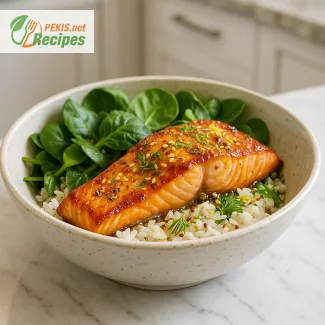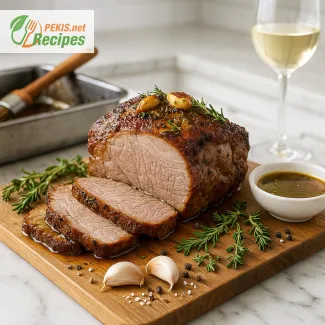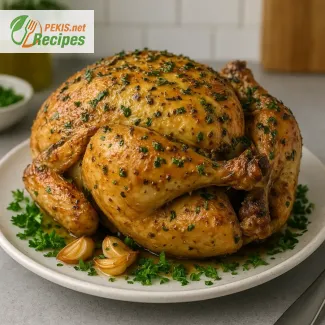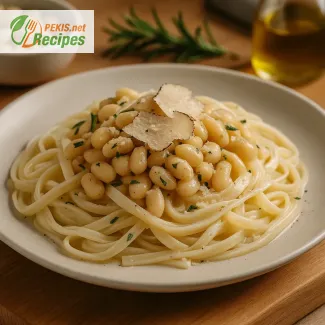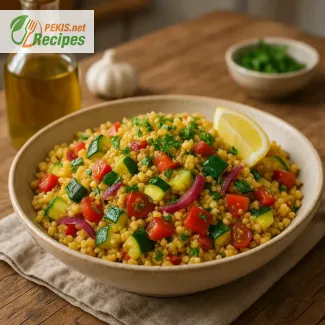
A wholesome twist on a Mediterranean classic
Discover the richness of roasted semolina couscous with vibrant vegetables
Few dishes offer the same culinary balance of health, taste, and versatility as a well-made couscous recipe. With roots stretching deep into North African and Mediterranean cuisines, couscous has evolved into a global favorite that pairs beautifully with a wide variety of ingredients—from hearty roasted vegetables to fragrant spices and fresh herbs. This particular version focuses on roasted semolina couscous, delivering a nutty depth of flavor and a light, fluffy texture that elevates the entire dish.
Whether you’re seeking a quick weeknight dinner or a plant-based side dish that impresses guests, this roasted couscous with vegetables is a perfect fit. Made with fine semolina grains, gently roasted until golden, and tossed with a medley of seasonal vegetables, it’s a vibrant and satisfying plate that can stand on its own or complement other mains. The beauty of couscous lies in its ability to absorb flavor, allowing every spice and drizzle of olive oil to enhance its character.
What makes roasted semolina couscous unique
Unlike standard steamed couscous, the roasted semolina version adds an extra dimension of flavor. The grains are lightly toasted before hydration, giving them a subtle earthy aroma and a more structured bite. This technique not only brings a toasted nuttiness but also improves the texture, ensuring that the couscous doesn't turn mushy or bland.
In this recipe, the roasting process is paired with seasonal vegetables such as zucchini, bell peppers, and cherry tomatoes, which are either pan-roasted or oven-baked until caramelized. When folded into the couscous with a hint of cumin, coriander, and lemon zest, the result is an aromatic, warm, and colorful dish that feels both familiar and exotic.
The role of spices and herbs in flavor development
A great couscous dish is only as good as its seasoning. Warm spices such as turmeric, paprika, and cinnamon are common in Moroccan-style preparations and pair especially well with roasted semolina. These spices are used with intention—not to overpower, but to enhance the natural taste of the couscous and vegetables.
Fresh herbs like parsley, mint, or cilantro are folded in right before serving, delivering a burst of green freshness that balances the warmth of the cooked elements. A finishing touch of freshly squeezed lemon juice brightens the entire dish and rounds out the flavor profile.
Texture and presentation: what to aim for
Properly prepared couscous should be light and fluffy, never sticky or clumpy. Roasting the semolina grains beforehand contributes to this goal, helping the grains to remain separate and absorb dressing or seasoning evenly. Visually, the contrast between golden couscous and jewel-toned vegetables creates an appealing and Instagram-worthy presentation, especially when garnished with chopped herbs or toasted nuts like almonds or pine nuts.
This dish is easily adaptable to different textures—crunchy roasted chickpeas, soft grilled eggplant, or creamy feta can all be added without compromising the base. This makes it ideal for both casual home cooks and professional chefs looking for a reliable vegetarian option that travels well and holds flavor over time.
Versatility for modern diets and lifestyles
Couscous is naturally plant-based, making it a go-to for those following vegetarian or flexitarian diets. It also works well in meal prep, as it maintains its quality after refrigeration and reheating. Served warm, at room temperature, or even chilled, it retains its character across settings—from lunchboxes and picnics to buffet tables and dinner parties.
This recipe allows for easy swaps, such as using whole wheat couscous for added fiber or incorporating legumes like lentils or chickpeas for extra protein. It can be served as a light main course, a side to grilled meats or fish, or as part of a mezze spread.
Ingredients that make the difference
The key to exceptional couscous lies in quality ingredients. Using authentic semolina couscous ensures the correct structure and flavor base. Extra virgin olive oil, freshly ground spices, and locally sourced vegetables add integrity and richness to the final plate. Even a small amount of preserved lemon or garlic confit can elevate the entire experience.
When ingredients are carefully selected and cooked with intention, even a simple couscous dish becomes a celebration of Mediterranean simplicity and global flavor.
- Toast the couscous: Place the dry couscous in a dry non-stick pan over medium heat. Stir constantly for 4–5 minutes until lightly golden and fragrant. Remove from heat and set aside.
- Prepare vegetables: In a large pan, heat half the olive oil (15 ml / 1 tbsp). Sauté the red onion and garlic for 2 minutes. Add zucchini, bell pepper, and cherry tomatoes. Season with salt, pepper, cumin, coriander, and turmeric. Cook over medium heat for 10–12 minutes until the vegetables are tender and slightly caramelized.
- Hydrate couscous: In a separate pot, bring water to a boil. Add the toasted couscous and remaining olive oil. Remove from heat, cover with a lid, and let it steam for 10 minutes. Fluff with a fork once all the liquid is absorbed.
- Combine: Add the cooked vegetables to the couscous. Mix gently. Add lemon zest, lemon juice, and chopped parsley. Toss to combine and taste for seasoning.
- Serve warm or at room temperature. Optional: garnish with toasted almonds or a drizzle of extra olive oil.
Elevate Your Couscous Dish with Simple Upgrades
Ingredient swaps and preparation tips for a richer, healthier experience
One of the most compelling aspects of a couscous recipe is its remarkable flexibility. While the traditional version using roasted semolina couscous and fresh vegetables offers a satisfying balance of flavor and texture, there are numerous ways to upgrade this dish both nutritionally and gastronomically. By understanding the interaction between ingredients, cooking techniques, and seasoning choices, you can take this humble recipe to an entirely new level.
How to enhance the flavor with additional ingredients
If you're looking to deepen the flavor profile, consider incorporating aromatic ingredients that naturally complement semolina couscous. Roasted garlic, for example, adds a mellow sweetness and complexity that fresh garlic doesn’t provide. Sun-dried tomatoes introduce an umami punch and a chewy contrast that enhances the texture of the dish.
For a smokier finish, adding a dash of smoked paprika or replacing regular bell peppers with fire-roasted varieties can deliver a more robust flavor. A sprinkle of toasted pine nuts or slivered almonds can add crunch and depth, while also enriching the dish with healthy fats.
Feta cheese, crumbled and stirred in just before serving, brings a salty tang that contrasts beautifully with the natural sweetness of roasted vegetables. If you're leaning toward a Middle Eastern twist, consider adding preserved lemon peel, harissa paste, or sumac for a citrusy, slightly tart complexity.
Health-conscious substitutions that don’t compromise taste
For those seeking a lighter version of the dish, switching to whole wheat couscous is a smart choice. It retains more fiber and has a slightly nuttier taste, making it more satisfying and digestively friendly. You can also replace part of the couscous with quinoa, which is gluten-free and offers complete protein, an excellent option for vegetarians or anyone aiming to reduce processed grain intake.
Instead of using sautéed vegetables in oil, try oven-roasting them with just a mist of olive oil spray. This method not only cuts down on calories but also intensifies the natural flavors of ingredients like zucchini, red onions, and cherry tomatoes.
Reduce the sodium content by minimizing added salt and opting for herb-based seasoning blends instead. Fresh herbs like basil, thyme, and dill offer layers of flavor that make additional salt unnecessary. And for a probiotic boost, consider serving couscous alongside a yogurt-based dip like tzatziki or a fermented pickle garnish.
Why homemade couscous is better than store-prepared versions
Cooking couscous at home allows for total ingredient control, ensuring that every element in your dish is fresh, clean, and tailored to your dietary needs. Pre-packaged couscous mixes often contain excess sodium, artificial flavors, or unhealthy oils, whereas homemade allows you to choose cold-pressed extra virgin olive oil, organic vegetables, and responsibly sourced semolina.
Moreover, homemade preparations give you the flexibility to adjust seasoning and texture, which is crucial for dishes meant to be served at gatherings or special events. Freshly prepared couscous retains its fluffiness and avoids the stickiness that often comes from sitting too long in containers or under heating lamps.
Common mistakes and how to avoid them
One of the most frequent errors is overwatering the couscous or letting it steam too long, resulting in a mushy texture. Always follow the correct water-to-couscous ratio, usually around 1.5:1 for roasted semolina couscous. Fluff the grains with a fork gently—never stir vigorously or compress the mixture, as this ruins the airy structure.
Another common misstep is underseasoning. Because couscous has a mild base flavor, it relies heavily on the seasoning mix and the depth added by vegetables and dressings. Don’t hesitate to layer spices—a pinch of turmeric here, a hint of cinnamon there—to build a complex, warm taste.
Lastly, many home cooks add vegetables straight from the fridge into the dish. Allow your vegetables to come to room temperature before cooking or roasting, which ensures even caramelization and enhances the final taste.
Making it meal-prep friendly and adaptable
Couscous is excellent for meal prep, but to keep it fresh and delicious, store the grains separately from the vegetables and any sauces or dressings. This prevents sogginess and allows for reheating only the necessary components. Add fresh herbs or lemon juice only when ready to serve, maintaining their brightness and vibrancy.
You can also convert this dish into a complete meal by adding a protein element: grilled chicken, pan-seared tofu, sautéed chickpeas, or even hard-boiled eggs pair beautifully with the existing base. This makes it suitable for lunchboxes, picnics, or as a substantial dinner option.
Seasonal variations to keep it interesting
Another way to enhance your couscous dish is by adapting it to the seasons. In the summer, focus on Mediterranean vegetables like eggplant, sweet corn, or roasted red peppers. In autumn, introduce butternut squash, mushrooms, or sautéed kale. Winter calls for root vegetables like carrots and parsnips, paired with warming spices like allspice and cinnamon.
During spring, incorporate asparagus, peas, or fava beans for a fresh and vibrant taste. These seasonal modifications not only keep the dish exciting but also ensure you're using produce at its peak, which contributes to better flavor and nutrition.
Garnishes and final touches that matter
Never underestimate the power of a good garnish. A final sprinkle of fresh herbs, a drizzle of flavored olive oil, or a dash of lemon zest can elevate the entire presentation and taste profile. For those who enjoy heat, a few drops of chili oil or a pinch of Aleppo pepper can add just the right amount of kick.
Presentation also counts—serve your couscous in a shallow, wide dish to showcase its colors and textures. A wedge of lemon on the side not only enhances the aesthetic but allows diners to customize the acidity level to their liking.
Allergens present in the recipe:
- Gluten (from semolina couscous)
Allergen substitution tips:
- Replace semolina couscous with gluten-free millet couscous or quinoa for a gluten-free alternative.
- Use certified gluten-free spices and bouillon if included.
Vitamins and minerals per serving (approximate):
- Vitamin C: 38 mg – supports immune function and collagen synthesis
- Vitamin A: 1200 IU – promotes vision and cell growth
- Vitamin K: 35 mcg – essential for blood clotting and bone metabolism
- Folate: 65 mcg – important for DNA synthesis and repair
- Iron: 2.1 mg – supports oxygen transport in blood
- Magnesium: 55 mg – aids muscle function and nerve signaling
- Potassium: 470 mg – regulates blood pressure and fluid balance
Antioxidants per serving (approximate):
- Lycopene: 5.2 mg – found in tomatoes, helps reduce oxidative stress
- Lutein + Zeaxanthin: 1.8 mg – protects eye health
- Beta-carotene: 1.5 mg – converts to vitamin A, supports skin and vision
- Polyphenols: 80 mg – from parsley, onions, and olive oil, anti-inflammatory effects
